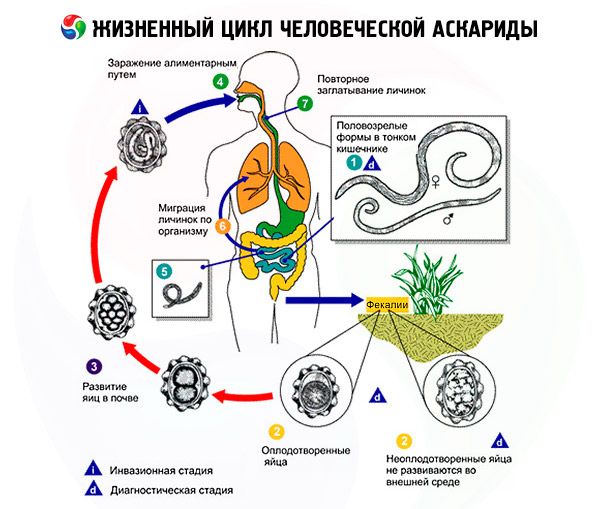
All iLive content is medically reviewed or fact checked to ensure as much factual accuracy as possible.
We have strict sourcing guidelines and only link to reputable media sites, academic research institutions and, whenever possible, medically peer reviewed studies. Note that the numbers in parentheses ([1], [2], etc.) are clickable links to these studies.
If you feel that any of our content is inaccurate, out-of-date, or otherwise questionable, please select it and press Ctrl + Enter.
Life cycle of the human ascarid
Medical expert of the article
Last reviewed: 06.07.2025
The life cycle of the human roundworm has its own characteristics, because its only host is a human. Therefore, the change of the place of parasitism of this worm contributes to certain symptoms and changes in the internal organs. For a complete diagnosis and prognosis of the development of the clinical picture in case of ascaris infection, it is necessary to know some features of its life cycle.
Sequence of events in the life cycle of the roundworm
Ascaris belongs to the class of flatworms, which affects some features of its structure and life. First of all, it is necessary to emphasize that the human ascaris is a heterosexual parasite, and such division into males and females requires special conditions not only for life, but also for reproduction.
The sequence of events in the life cycle of the roundworm begins with the moment the eggs enter the human body. Then, according to the different forms of maturity of this worm, there are also different stages of development. The egg then, in the process of growth, turns into a small larva, then into a large larva, and only then into an adult.
All these stages are sequential and change according to the location in the human body. Therefore, several stages are distinguished - intestinal, systemic (circulatory), parenchymatous (liver and lung) and then the whole cycle is repeated after reinfection.
In general, the life cycle of the human roundworm takes about a year, but this is the case if one individual gets in and goes through all these stages. But most often, several eggs get in at once, and at each stage there can be several parasites, which leads to long-term persistence of the roundworm in the human body - this can last for years. During this time, the roundworm releases its waste products into the intestinal lumen, which leads to the development of clinical symptoms.
When the female lays eggs, some of them undergo new development cycles, and some are excreted with feces, which can be determined in tests. Considering that the parenchymatous phase of the life cycle can be in the form of an encapsulated larva, there may not be any pronounced symptoms. Therefore, when confirming the diagnosis of ascariasis, it is necessary to take into account that this parasite can be at different stages of development in the human body, including not excluding parenchymatous forms.
Characteristics of the life cycle of the human roundworm
The intestinal phase of the development of the roundworm begins when the pathogen enters the human body, namely the small intestine. There, the eggs are activated and they leave their shell. Then a small form of larva is formed, which is fixed to the inner wall of the villi of the small intestine and penetrates the blood vessels, namely the veins. Then the scheme of the life cycle of the human roundworm consists of migration.
The small form of the larva, getting into the blood, feeds on the serum of the blood plasma, and then on the erythrocytes. At the same time, the larva grows and increases in size. With the blood flow, the larva through the portal vein system from the intestine gets into the liver, where the parasite's residues can remain in the form of encapsulated larvae. In the liver, the ascaris larvae can be located around the liver beams and squeeze the intrahepatic bile ducts.
Then symptoms from the liver appear in the form of bile outflow disorders. But such a location may not affect the bile ducts and there may be no symptoms. Then the larvae migrate with the blood flow from the liver along the inferior vena cava to the right ventricle of the heart and through the pulmonary artery system enter the lungs.
Ascaris has its own characteristics, since it needs oxygen to survive. That is why the human lungs are one of the intermediate organs that the ascaris passes through during its life. The lungs may also contain encapsulated forms of larvae, but with such localization, an asymptomatic course is more typical. This is due to the fact that the lungs do not have pain receptors, there may be only minor painful sensations when the larvae are localized near the parietal pleura. Such a location can cause a reflex cough, which in turn contributes to further migration of the parasite.

With a cough, the roundworm gets into the throat, and then back into the intestines - this is how the intestinal phase is repeated. But at the same time, the individuals are fully mature forms, these are worms that reach several tens of centimeters and can reproduce. So the entire life cycle of the roundworm is repeated and the number of individuals increases each time. Therefore, given the complex migration path of the roundworm, when establishing a diagnosis, it is recommended to conduct an ultrasound of the liver and lungs, which allows you to identify the larvae of the pathogen and conduct adequate treatment.


 [
[